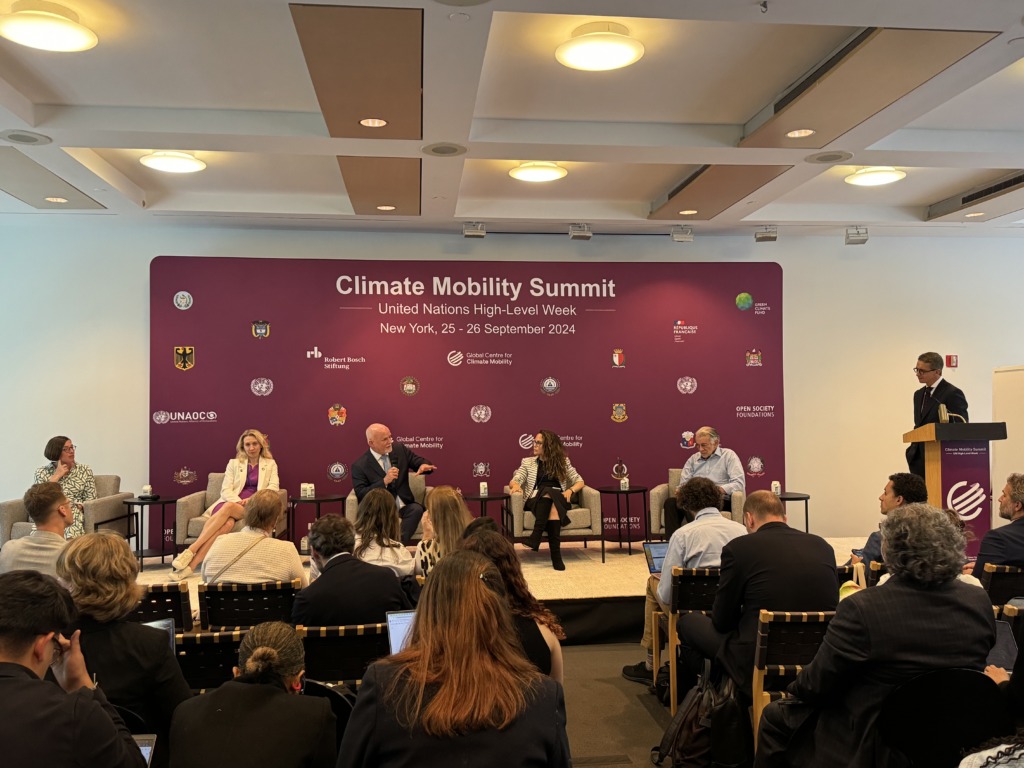People are increasingly on the move due to climate change.
Floods, storms, wildfires, and other climate events force people to leave their homes as the disaster nears or hits. Other phenomena like droughts can slowly chip away at peoples’ resilience—and exacerbate vulnerabilities from human rights, economic, and political pressures that force people to look elsewhere for safety and stability.
Despite this growing reality, national and international laws or policies are not equipped to deal with the full scale of the human mobility impacts of climate change.
The Global Refuge Advocacy team recently attended the 2024 Climate Week NYC—a massive gathering of practitioners from public policy, philanthropy, the private sector, science, and other disciplines focused on the climate crisis.
Here are some top takeaways from Climate Week NYC and the Climate Mobility Summit, a series of panels hosted by the Global Center for Climate Mobility.

1. Climate-related displacement is here to stay.
Reports and interventions during Climate Week NYC emphasized how climate-related migration and displacement are active trends that communities are facing in real time.
“It’s not a distant threat,” said Dr. Joyelle Trizia Clarke, a minister for St. Kitts and Nevis. “For small island developing states, it’s an omnipresent and very sobering reality.”
A new International Refugee Assistance Project report found that asylum seekers from Central America are already facing climate shocks in their countries of origin and in transit.
Large-scale internal movements within countries are expected due to climate change, particularly as part of broader rural-urban migration patterns. A new report from C40 Cities details how millions will likely be on the move to cities in the Global South like Dhaka, Bangladesh; Karachi, Pakistan; Bogotá, Colombia; São Paolo, Brazil; and Amman, Jordan.
These trends are not just relevant to agencies or practitioners that work on climate or immigration. Climate displacement at its core disrupts community cohesion, upends livelihoods, and erodes identities—so it deserves to be a top agenda item across sectors.
2. Climate mobility responses ought to be flexible and strong on protection.
Climate mobility can take many different forms. Consider how…
- Most climate-related displacement occurs within countries, but some people displaced by climate change cross an international border.
- Displacement can be temporary—as people may return after a climate-related disaster. However, it can also involve permanent relocation to a new area when a slow-onset climate trend like desertification, sea-level rise, high heat and humidity, or coastal erosion makes an area less habitable, or even uninhabitable.
- A climate-related disaster can be the sole reason an individual or family moves—or it may overlap with other drivers of displacement, such as human rights abuses, targeted persecution, weak governance, or economic stagnation.
Pathways in response ought to reflect the situations and choices people will face. There is no silver bullet answer here—but rather a suite of options to improve temporary or permanent humanitarian, circular, and labor-based pathways at various levels.
Practitioners and advocates are divided on the question of labor pathways in response to this challenge. Labor-based pathways may facilitate cross-border movement, but others are concerned that labor-based solutions will result in the exploitation of vulnerable populations and do not center the rights of people on the move for largely humanitarian reasons. However, there is broad agreement that labor-based pathways and solutions need to be “protection-sensitive,” and should not occur in isolation from other policy options.
Global Refuge believes there should be climate-specific humanitarian pathways for people to resettle safely, such as the Climate Displaced Persons Act in the United States. Until that bill becomes law, the United States can still improve existing humanitarian programs such as Temporary Protected Status, access to territorial asylum, and processing in the U.S. Refugee Admissions Program to help meet the needs of climate-displaced people.
3. Climate mobility includes the right to stay.
Policies on climate mobility need to take into account that many people do not want to move from their homes and should not feel forced or compelled to move in the first place.
Climate adaptation and loss and damage (L&D) work is critical to ensuring people have the resources and support they need to stay in their homes and not be forcibly displaced.
“We just want a chance to stay,” said Climate Refugees executive director Amali Tower, recalling the voices of young people affected by drought in Guatemala and Honduras.
Nature-based solutions like mangrove reforestation can combat coastal erosion and sea-level rise. Urban planners can use data to predict which informal settlements may be prone to flooding. Other infrastructure can be designed in a way to minimize climate impacts.
Communities affected by climate change have a right to information that can improve their climate resilience, such as access to early warning systems. They also should be included in the designs of climate adaptation policies and systems.
As one Climate Mobility Summit speaker noted, migrant populations can be active participants in climate adaptation work, rather than mere passive recipients of assistance. Funding should flow to L&D efforts in climate-vulnerable states that seek to remedy climate impacts that the international community is unable to avoid.
4. Climate mobility belongs in larger discussions about humanitarian reform.
Aid budgets are increasingly struggling to meet soaring humanitarian needs amid protracted and emerging crises—from Sudan to Ukraine and numerous other contexts.
During a ministerial-level meeting in New York, U.S. Secretary of State Antony Blinken said the international community needs to improve cohesion between humanitarian and development actors, deepen support for refugee-hosting countries, and expand cooperation with the private sector.
“This era of severe and protracted crises requires us to fundamentally reevaluate our current humanitarian system,” Blinken said.
Elizabeth Campbell, Deputy Assistant Secretary of State for the U.S. Bureau of Population, Refugees and Migration, said donor countries need to recognize how climate mobility features into the shifting humanitarian landscape.
“Violence may be what captures the global media headlines, [but] there is always a climatic component,” Campbell said.
Campbell said the bureau needs to engage a wider group of stakeholders and improve financing mechanisms on climate adaptation, such as the Green Climate Fund.
Climate mobility efforts also need to be part of the larger localization agenda in humanitarian affairs to channel money, resources, capacity, and other support to local organizations, especially refugee-led organizations.
5. To that end, affected communities must be centered.
As part of broader humanitarian conversations like meaningful refugee participation at the Global Refugee Forum, international fora and policymaking bodies need to elevate the expertise and perspectives of those most directly affected by climate change, displacement, and fragility.
“Centering the stories of people who are living these experiences is absolutely essential,” said Pathways International CEO Jennifer Bond.
The Climate Mobility Summit featured leaders from low-lying island states at risk from sea-level rise such as Tuvalu and Cape Verde, as well as youth activists from Costa Rica, the Marshall Islands, and elsewhere. It also included representatives of climate-vulnerable countries hosting high numbers of displaced people, such as Colombia and Uganda.
Climate Mobility Summit panelists discussed how climate-displaced and climate-affected communities must continue to be engaged directly and substantively.
“One critical actor that is often missing is the displaced population,” said Ana Aguilera de Llano from the World Bank. “We need to give them a seat at the table.”
6. SMOs may be understood as a climate mobility response and potential model.
The United States is processing historic numbers of refugees from the Western Hemisphere in large part due to the Safe Mobility Offices (SMOs), an initiative to process migrants in Guatemala, Costa Rica, Colombia, and Ecuador for lawful pathways.
Campbell said the SMOs seek “to meet people where they are, to assess what their needs are, [and] why they’re moving, sometimes for climatic reasons.” She added that registrants at SMOs have been displaced by persecution, poverty, or a combination of factors.
Individuals are screened at SMOs for risk factors or protection concerns, such as whether they meet the refugee definition. Lawful options through the SMOs can include third-country resettlement or labor or education pathways, Campbell said.
“For us, this is what we are trying to bring to bear and to build in the Western Hemisphere to address the massive movement of people for a wide variety of reasons,” Campbell said. “It’s something that we think will increasingly become the way that we have to address these issues globally, to include across the African continent.”
Global Refuge and others have called on the Biden administration to use the SMOs to expand access to protection for climate-affected refugee populations in Latin America.
For more resources and background on climate-related displacement, go to Global Refuge’s Climate Displacement Hub.

